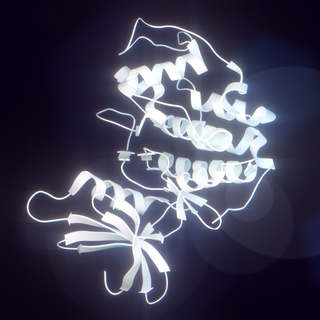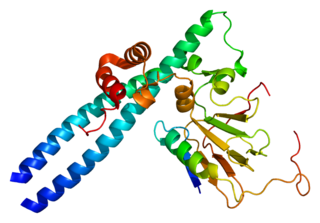G1/S-specific cyclin-D3 is a protein that in humans is encoded by the CCND3 gene. [5]
G1/S-specific cyclin-D3 is a protein that in humans is encoded by the CCND3 gene. [5]
The protein encoded by this gene belongs to the highly conserved cyclin family, whose members are characterized by a dramatic periodicity in protein abundance through the cell cycle. Cyclins function as regulators of CDK kinases. Different cyclins exhibit distinct expression and degradation patterns which contribute to the temporal coordination of each mitotic event. This cyclin forms a complex with and functions as a regulatory subunit of CDK4 or CDK6, whose activity is required for cell cycle G1/S transition. This protein has been shown to interact with and be involved in the phosphorylation of tumor suppressor protein Rb. The CDK4 activity associated with this cyclin was reported to be necessary for cell cycle progression through G2 phase into mitosis after UV radiation. [6]
Mutations in CCND3 are implicated in cases of breast cancer. [7]
Cyclin D3 has been shown to interact with:

Cyclin-dependent kinase 4 also known as cell division protein kinase 4 is an enzyme that in humans is encoded by the CDK4 gene. CDK4 is a member of the cyclin-dependent kinase family.

Cyclin-dependent kinase 9 or CDK9 is a cyclin-dependent kinase associated with P-TEFb.

Cyclin-dependent kinase 1 also known as CDK1 or cell division cycle protein 2 homolog is a highly conserved protein that functions as a serine/threonine protein kinase, and is a key player in cell cycle regulation. It has been highly studied in the budding yeast S. cerevisiae, and the fission yeast S. pombe, where it is encoded by genes cdc28 and cdc2, respectively. With its cyclin partners, Cdk1 forms complexes that phosphorylate a variety of target substrates ; phosphorylation of these proteins leads to cell cycle progression.

Transcription factor E2F1 is a protein that in humans is encoded by the E2F1 gene.

Cyclin-T1 is a protein that in humans is encoded by the CCNT1 gene.

M-phase inducer phosphatase 1 also known as dual specificity phosphatase Cdc25A is a protein that in humans is encoded by the cell division cycle 25 homolog A (CDC25A) gene.

G1/S-specific cyclin-D2 is a protein that in humans is encoded by the CCND2 gene.

M-phase inducer phosphatase 2 is an enzyme that in humans is encoded by the CDC25B gene.

CDK-activating kinase assembly factor MAT1 is an enzyme that in humans is encoded by the MNAT1 gene.

G1/S-specific cyclin-E1 is a protein that in humans is encoded by the CCNE1 gene.

Cell division control protein 6 homolog is a protein that in humans is encoded by the CDC6 gene.

Cyclin-A1 is a protein that in humans is encoded by the CCNA1 gene.

Cyclin-A2 is a protein that in humans is encoded by the CCNA2 gene. It is one of the two types of cyclin A: cyclin A1 is expressed during meiosis and embryogenesis while cyclin A2 is expressed in dividing somatic cells.

Cyclin-C is a protein that in humans is encoded by the CCNC gene.

Cyclin-dependent kinase 4 inhibitor D is an enzyme that in humans is encoded by the CDKN2D gene.

Protein HEXIM1 is a protein that in humans is encoded by the HEXIM1 gene.

Cyclin-T2 is a protein that in humans is encoded by the CCNT2 gene.

Cell division protein kinase 3 is an enzyme that in humans is encoded by the CDK3 gene.

Cyclin-dependent kinase inhibitor 3 is an enzyme that in humans is encoded by the CDKN3 gene.

Cyclin-dependent kinase 2-associated protein 1 is an enzyme that in humans is encoded by the CDK2AP1 gene.